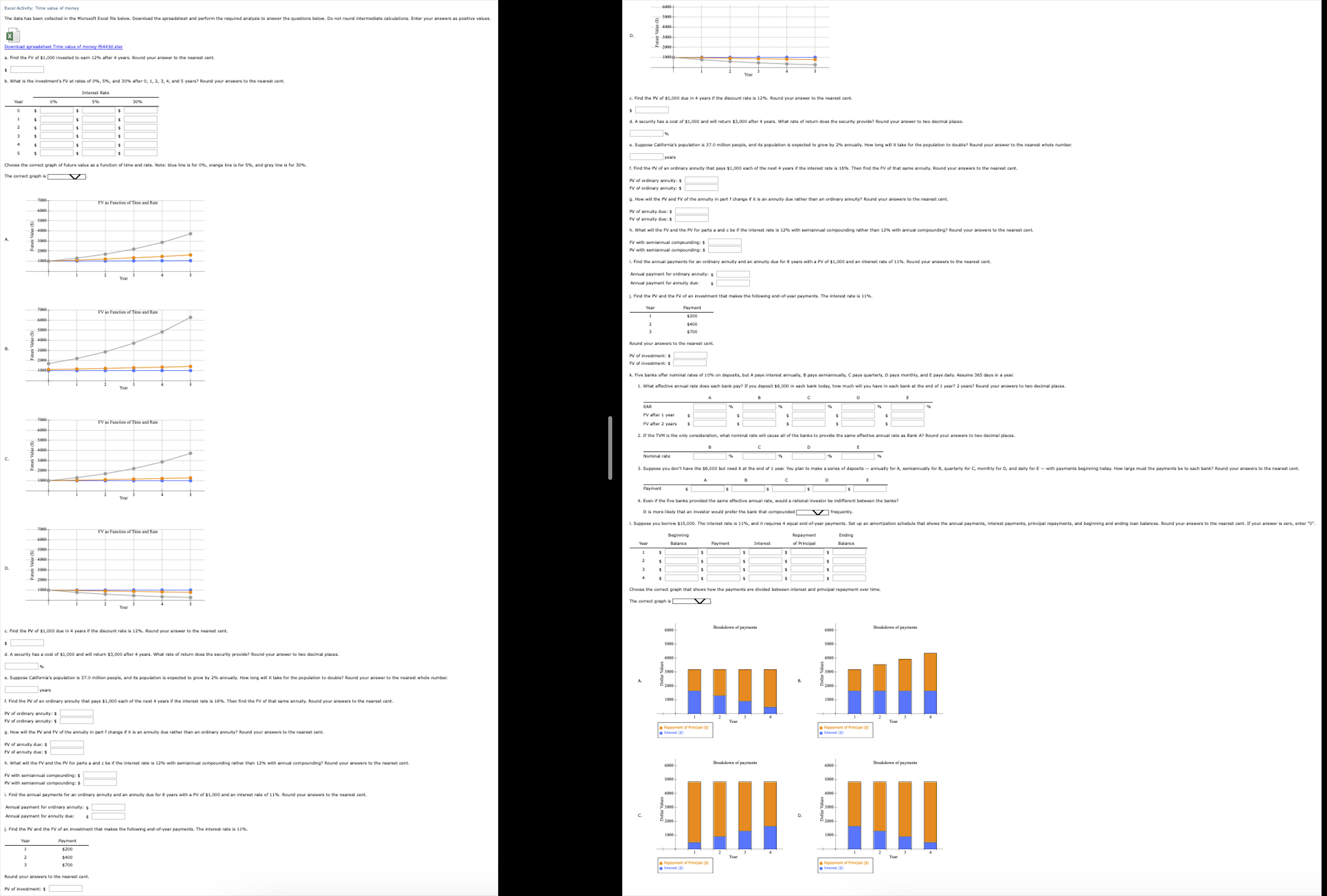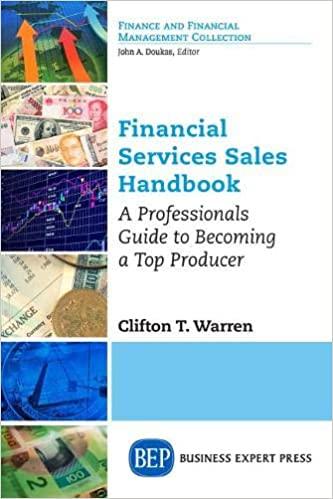Answered step by step
Verified Expert Solution
Question
1 Approved Answer
Question 1 0 / 1 0 Submit Question Content Area Excel Activity: Time value of money The data has been collected in the Microsoft Excel
Question
Submit
Question Content Area
Excel Activity: Time value of money
The data has been collected in the Microsoft Excel file below. Download the spreadsheet and perform the required analysis to answer the questions below. Do not round intermediate calculations. Enter your answers as positive values.
Download spreadsheet Time value of moneyfdxlsx
a Find the FV of $ invested to earn after years. Round your answer to the nearest cent.
$ fill in the blank
b What is the investment's FV at rates of and after and years? Round your answers to the nearest cent.
Year Interest Rate
$ fill in the blank
$ fill in the blank
$ fill in the blank
$ fill in the blank
$ fill in the blank
$ fill in the blank
$ fill in the blank
$ fill in the blank
$ fill in the blank
$ fill in the blank
$ fill in the blank
$ fill in the blank
$ fill in the blank
$ fill in the blank
$ fill in the blank
$ fill in the blank
$ fill in the blank
$ fill in the blank
Choose the correct graph of future value as a function of time and rate. Note: blue line is for orange line is for and grey line is for
The correct graph is
A
B
C
D
c Find the PV of $ due in years if the discount rate is Round your answer to the nearest cent.
$ fill in the blank
d A security has a cost of $ and will return $ after years. What rate of return does the security provide? Round your answer to two decimal places.
fill in the blank
e Suppose California's population is million people, and its population is expected to grow by annually. How long will it take for the population to double? Round your answer to the nearest whole number.
fill in the blank
years
f Find the PV of an ordinary annuity that pays $ each of the next years if the interest rate is Then find the FV of that same annuity. Round your answers to the nearest cent.
PV of ordinary annuity: $ fill in the blank
FV of ordinary annuity: $ fill in the blank
g How will the PV and FV of the annuity in part f change if it is an annuity due rather than an ordinary annuity? Round your answers to the nearest cent.
PV of annuity due: $ fill in the blank
FV of annuity due: $ fill in the blank
h What will the FV and the PV for parts a and c be if the interest rate is with semiannual compounding rather than with annual compounding? Round your answers to the nearest cent.
FV with semiannual compounding: $ fill in the blank
PV with semiannual compounding: $ fill in the blank
i Find the annual payments for an ordinary annuity and an annuity due for years with a PV of $ and an interest rate of Round your answers to the nearest cent.
Annual payment for ordinary annuity: $ fill in the blank
Annual payment for annuity due: $ fill in the blank
j Find the PV and the FV of an investment that makes the following endofyear payments. The interest rate is
Year Payment
$
$
$
Round your answers to the nearest cent.
PV of investment: $ fill in the blank
FV of investment: $ fill in the blank
k Five banks offer nominal rates of on deposits, but A pays interest annually, B pays semiannually, C pays quarterly, D pays monthly, and E pays daily. Assume days in a year.
What effective annual rate does each bank pay? If you deposit $ in each bank today, how much will you have in each bank at the end of year? years? Round your answers to two decimal places.
A B C D E
EAR fill in the blank
fill in the blank
fill in the blank
fill in the blank
fill in the blank
FV after year $ fill in the blank
$ fill in the blank
$ fill in the blank
$ fill in the blank
$ fill in the blank
FV after years $ fill in the blank
$ fill in the blank
$ fill in the blank
$ fill in the blank
$ fill in the blank
If the TVM is the only consideration, what nominal rate will cause all of the banks to provide the same effective annual rate as Bank A Round your answers to two decimal places.
B C D E
Nominal rate fill in the blank
fill in the blank
fill in the blank
fill in the blank
Suppose you don't have the $ but need it at the end of year. You plan to make a series of deposits annually for A semiannually for B quarterly for C monthly for D and daily for E with payments beginning today. How large must the payments be to each bank? Round your answers to the nearest cent.
A B C D E
Payment $ fill in the blank
$ fill in the blank
$ fill in the blank
$ fill in the blank
$ fill in the blank
Even if the five banks provided the same effective annual rate, would a rational investor be indifferent between the banks?
It is more likely that an investor would prefer the bank that compounded
frequently.

Step by Step Solution
There are 3 Steps involved in it
Step: 1

Get Instant Access to Expert-Tailored Solutions
See step-by-step solutions with expert insights and AI powered tools for academic success
Step: 2

Step: 3

Ace Your Homework with AI
Get the answers you need in no time with our AI-driven, step-by-step assistance
Get Started


